When there is a societal breakdown, be it localized rioting or a nationwide crisis, looting becomes a major concern that we need to take seriously; while we can not always prevent looters from entering and looting our homes, we should always have a way to escape and disappear.
This is where an invisible shelter comes into play.
Goals of an Invisible Shelter
The goal is to construct a shelter hidden from view that is appropriate to spend a night or two inside while waiting for the unrest to end.
These shelters can be built in urban areas, the wilderness, or forested areas within the urban environment.
Related: Emergency Shelters When You Are On The Move
What Makes a Shelter Invisible?
Being hidden from view is only a small part of making a shelter invisible. There are several other factors essential to remaining undetected.
- Keep your shelter far enough from any trails, paths or roads so that you will be out of sight, and any smells or sounds from your shelter will be masked or muffled to people walking by.
- There should be some barrier or deterrent to prevent anyone from approaching the shelter location.
- Keep the shelter as low to the ground as possible.
- No fires or cooking.
- No talking. When you need to communicate, whisper into the other persons’ ear with cupped hands.
- No artificial lights.
- No unnecessary movement.
- Always have your bug-out bag packed and ready to go. Everything that you take out must be returned and secured when done using it.
- Always have at least one person on sentry. Their job is to watch but also to listen for approaching people.
Invisible Shelter On Your Property
When a band of looters wants to break into your home, the best option is to retreat and regroup. Hopefully, you have taken measures to conceal your preparations and have hidden caches so that any loss from the looting will not affect your overall survivability.
Having invisible shelters on your property will require an investment of time, energy and materials long before your front door is kicked in.
The first step is to walk around your property and locate areas that you could construct a shelter large enough to house your family for the duration of the looting.
Fortunately, gangs of thugs that roam around looting are likely to move on to other targets rather quickly, so there is little likelihood of spending more than a night in an invisible shelter on your property.
Some examples would be:
• If you have a large property, you could build a small shelter then disguise it as a debris pile.
Related: How To Build A Survival Debris Hut
• If you have the time and equipment, digging an underground shelter is a viable option but requires skill and engineering. Hide the entrance to such a shelter under common backyard items such as a doghouse.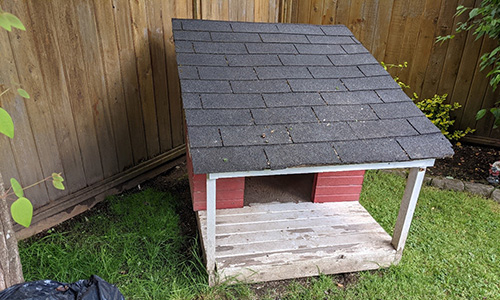
The problem with shelters such as these is that they often do not have the escape route options that other shelter locations may offer.
Likewise, creating a hidden refuge within your home, such as a panic room, suffers from the same lack of escape routes.
Urban Shelter Options
Urban environments do not leave a lot of options for seeking shelter from looters. Suppose you are in a situation where you need to leave your home due to looting; it is best to have possible shelter sites located beforehand.
The main issue is that suitable locations may be occupied by either the homeless or others like yourself.
Abandoned buildings are an option to consider, and you should know which buildings in your area are vacant.
Likewise, if you are close to an industrial area, there is a good possibility that you will find many empty commercial buildings that you can use for temporary shelter.
This option is not legal and should only be used in a dire emergency, also if you do find yourself in a situation where you need to use an abandoned building, leave no trace that you were there and avoid causing any damage.
Tunnels, overpasses, or bridges can offer shelter but will be popular options for other people as well.
Related: How to Get a Cheap Survival Shelter and Bug Out Location (Under $5000)
One of the best ways to plan for building an invisible shelter is to walk around your neighbourhood within a block or two radius, looking for spaces that you can access with minimal difficulty that can house you and your family for a short time.
Some examples are fenced-off mechanical areas, rooftops, etc.
Even the space between a hedgerow and a building can provide effective shelter; large trees can sometimes have places within them where you can hide.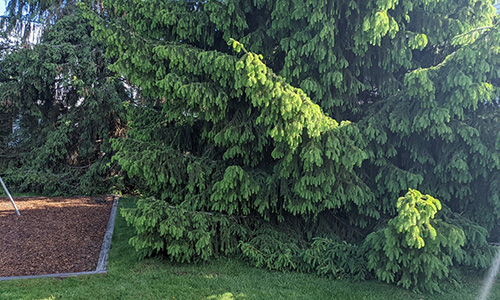
Wilderness and Urban Forests
Establishing a shelter in a wilderness or urban forest is the most effective and easiest means of building an invisible shelter.
You should scout possible locations beforehand so that when you need to evacuate your home in the wee hours of the morning, you know exactly where you will go.
Look at areas of dense foliage that block the view of anyone passing by. As long as it is difficult to look over them, you can clear a place out of sight from passersby to pitch a simple low profile tarp shelter without anyone being able to observe you.
You can also cut entrance and escape routes through the thick brush and camouflage their entrances with brush rendering the shelter area invisible.
Each of your family members’ bug-out bags needs to have a shelter kit that should have a tarp, paracord, and tent stakes.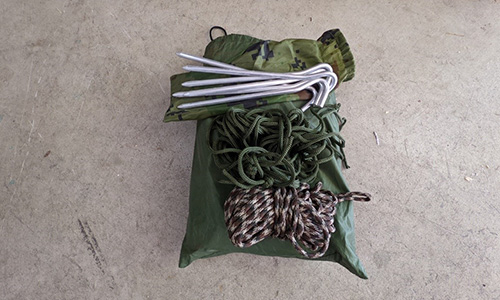
Related: 13 Shelters That You Can Build With A Military Poncho
The location of your invisible shelter will be entirely dependant on your area and the environment in which you live. Regardless of where you live, you need to follow a few fundamental rules when constructing a shelter you intend to keep invisible.
• Your tarp needs to be earth-toned or camouflage to blend into the environment.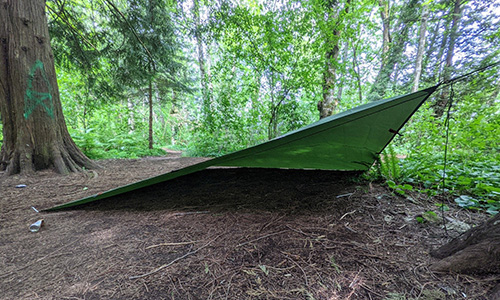
• When pitching the tarp, keep it very low to the ground. You should have enough room for yourself and maybe one other person along with your gear. Only leave enough headroom under the trap so that your body does not touch the tarp material.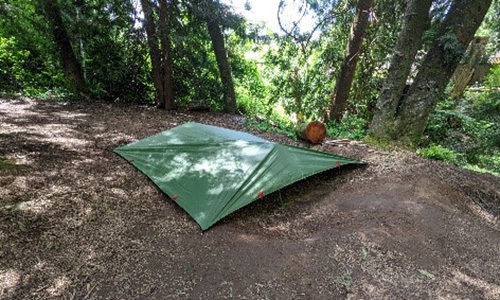
• It may be difficult to use natural materials to camouflage a tarp without causing the material to sag, and this takes time that you may not have in abundance. It is better to keep your shelter out of view than to spend hours camouflaging it.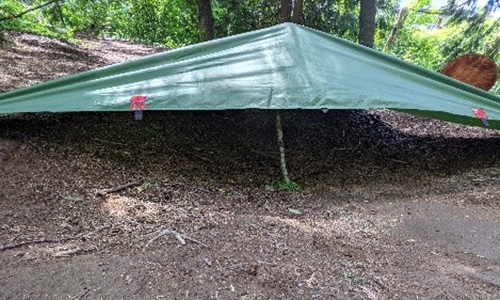
• You can dig down into the ground in dryer seasons and climates to create a depression to hide from view further.
Final Words
While it is possible to construct a shelter that is effectively invisible without any prior preparation, it is far better to do a little work beforehand to make it easier to vanish from looters.
Remember that what makes you truly invisible is more to do with what you do in and around the shelter rather than the actual shelter itself.
You may also like:
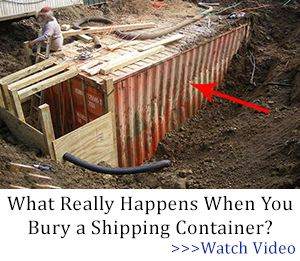 If You Don’t Have These 7 Items, You Are Not Really Prepared
If You Don’t Have These 7 Items, You Are Not Really Prepared
How To Make Your House Invisible To Looters (Video)
50 Low-priced Items That Will be Invaluable when SHTF
How to Safely Clear Your Home When You Think There’s an Intruder

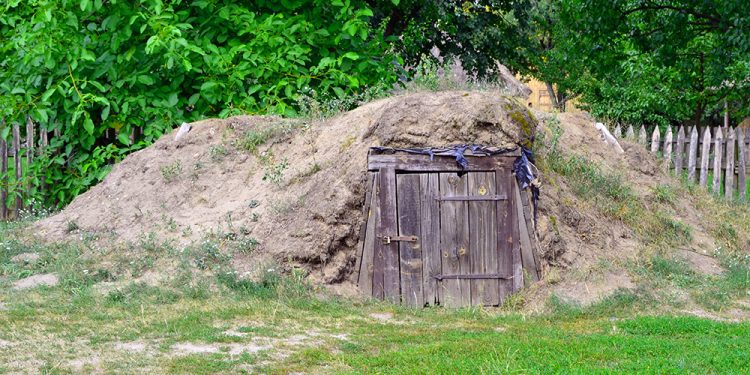




















Good Article, sensible. I especially like the mention of pre placed caches so when NOT if your home gets a rude visit you still have something to survive and rebuild with.
The typical American home is NOT even bullet resistant and very flammable. Not the place you want to make your Alamo.
The Alamo for example was a semi-fortified Church made of thick adobe walls (READ Concrete) and fired pottery shingles. Thus with a bit of work Davy Crockett and friends were able to hold off serious troubles for quite a while as General Santa Anna came to visit. It took the Mexican Armies cannons to breach the walls for the final bayonet assaults.
Our typical homestead house will not stop a mere 22 long rifle bullet nor a single Molotov cocktail from a crazy.
Why do you need TRUSTED friends and caches when things get CRAZY? You have to sleep sometime, whos got your back and many hands make light work maybe and how would YOUR Survival supplies be looking like after you were salvaging from YOUR burnt out home?
The remaining building we call The Alamo was the chapel of a larger compound enclosed by a rudimentary wall. The S.E. corner of the wall had collapsed decades earlier and been repaired with brush, rubble, and an old wagon. The Texans chose to defend the walls, knowing they lacked the men to hold. Santa Anna sat outside the walls for 12 days taking no action. Before dawn on the 13th day he attacked. He had 500 mounted Lancers in his army, his professional troops, and some 1800 peasants who had never held a gun in their lives, let alone fired one. He sent his raw foot soldiers against the Texan strong points, keeping his Lancers behind the peasants to kill anyone who ran. The no doubt terrified peasants drifted around the walls, taking several hundred casualties until they entered through the weak points in the wall and opened the gates for the Lancers, ending the battle. The assault lasted about an hour, the Mexicans having approached the walls under cover of darkness, killing the Texian pickets who had fallen asleep.
Houston had ordered Travis and Bowie to abandon the compound, the problem was 4 men had been appointed Commander of The Army by 4 different political factions so Travis and Bowie were free to ignore Houston. Fannin had also been given command of the Army and decided to reinforce the Alamo but he and his men were slaughtered before they had the chance. Houston was left in command, winning the war finally when he caught the Mexican Army sleeping while Santa Anna partied with a whore. Amazing how incompetent almost all Generals have been and continue to be.
Anyway, the salient point of the article is don’t try to defend your home against an attack because you are just like the Alamo. Just imagine a round of .276 going through the front wall of your home and continuing out the back wall.
Words to remember. I was surprised to see how tiny the Alamo actually is. However it was an element in a compound of other structures.
Thank you for all you are sending us that is so very useful.
Cool topic, creating a hidden shelter something that I’ve thought about a lot. But the biggest problem with any hidden shelter is that corrosion and pests are a big issue. Large containers fail, and metal rusts. You need a happy medium. Something that is water proof, doesn’t corrode, can store something air-tight, and also be portable. That’s why I bought several of these geo-cache’s. You can get the small or large (I like both) and they work amazing!
https://www.amazon.com/dp/B001QDNACU?_encoding=UTF8&th=1&psc=1&linkCode=ll1&tag=fsbastore-20&linkId=ec0989e08023a5e6ee77938962e2bdcd&language=en_US&ref_=as_li_ss_tl
We’ve planned a spot on our yard. Under a leanto added to a small garden shed. Extra canning jars, stored baking pans, and yard hand tools will be there. A bin with light objects will be attached to a hinged entrance through the floor. It will have two cut in benches in the dugout for sitting or sleeping. An old trunk will hold desired items such as a small cook pot, lanterns and flashlights that use AA or AAA batteries, a small solar charger for the batteries, a pr of walki talkies, a machete, and a change of clothing for each. An alpurpose bug out bags with some first aid items. That way it can be a hiding place to leave from if necessary. Or a base to leave and return to and eat a few prepared items whatever the circumstance is. A cross bow and bolts or my old long bow and arrows for quiet hunting. Wild edibles that resemble nothing more than a weed patch are all around.
We live in a small mobile home. Totally vulnerable to fire or bullets. Underneath are cans of freeze-dried foods and grains. Not too hard to access but not in plain sight either. The “hole” will have some canned goods and a can opener, silverware, paper plates and bowls et. In case it’s a hiding place for more than a few days. The shed and leanto floors combined are 8’x8′. I planning on the hole being 6’x7′ with a reinforced roof below the floors that are sheets of 3/4″ plywood. The floors sit above ground about 4″. A step ladder will sit under the “hatch” and can be folded out of the way when the hole is occupied. If I’m able to make the room larger it will also be a root cellar. I have a campershell that is a 12v freezer. That could be parked on a larger hole to stop folks from walking on the “dirt” over that part of the hole. A roof set 4″ below ground level puts it 8″ below the shed floors and a larger hole part of it would have 4″ of dirt above part of it. Not good to hear a hollow sound walking on it. So i can park the mobile freezer there. I could also park an older overhead camper there as well. It’s much heavier so just parked in the line but not necessarily over the the hole. I use that camper for my grandsons to stay in when they visit. Overhead bed, table and benches make bed. It has a toilet with a portable holding tank, a three way refrigerator, 12v, propane, 110v. A three burner propane stove and a sink with potable and gray water tanks. I keep cookware, food, towels, bedding, and TP there.
I’ve already started laying building materials there for the Ieanto. I will dig the hole, frame over it and add the 1/2″ plywood roof on it then build the leanto attached to a garden shed. The shed floors sit 4″ above the ground and dirt mounds up to create runoff drainage away from the base. The leanto will match the shed. The entrance will be a trapdoor with an attached storage bin of light items. The “roof” plywood will have a second door that drops inward on the hole with screen door hooks above and below so it can be latched shut to keep out small vermin.
In our big shop building further away from the home there is an already dug oil change pit. It will be roofed with framing and plywood and covered with dirt. An old vehicle will be parked over the pit with an opening to crawl to under the vehicle. 2 sleeing bags to sit on or lay on and snackables will be there along with another matching pair of walki talkis and a small solar battery charger. Maybe a change of clothing and a simple weapon and a machete. If we had to leave. Pits are good cover but really tempory for safety.
Thanks Michael for a well thought out article.
I have a plan for two areas on my property. One in a shop the other under ground in the backyard. Blackberries are going in along the back side of the building and roses across the front. (Lots of thorns) When the hole is enlarged a leanto is being built on with a side entrance. The existing tiny shed has a little porch with a side opening. It will all be old weathered plywood. Old reused corrugated metal roofing. It won’t look special. All of it will store gardening tools, old unused glass canning jars, the waterbath canners and canning accessories. There is a path but since it’s storage and gardening tools it looks logical. I planned a folding ladder to sit under the trap door. I may have to change that and use a pool ladder because my husband is getting weaker and more unsteady. We’re both great grandparents. I wanted the folding ladder to open up the space once we were inside.
I’d like to replace the roof here with a flat adobe. The structure should be strong enough to hold it but to beef up the walls, solid concrete ‘adobe’ blocks would be best. Any roof is vulnerable, but not so much a flat roof several inches thick. Also, replacing the wood attached garage would be wise. For that, adobe block either stabilized or kilned. The front yard is growing well, all food plants, all thorny, in and around deep, soft spots. A neighbor just uphill is armed to the teeth. From Mexico and a legal citizen here, she’s very into guns as are her kids and now her grandchildren. It’s the same all over town. niio
This was exceptionally good. Hiding as well as you can sounds like the best strategy, besides forethought in preparation. I think excessive visibility will kill a lot of people. A situation like the one we’re imagining is a lot to plan for, a lot to juggle mentally, and will be a serious test of ethics.
On the other hand, for suburban dwellers who have a handkerchief sized yard, sand bags are about 50¢ each at the local nursery store. We use them extensively in SoCal whenever it rains which appears to be about once every three years now. While you are digging your sanitary trench, the excess dirt can go in the sandbags. If you have large trash cans, they can be filled with dirt and two or three of them, depending upon size, with the dirt compacted will act as barriers to all but a .50 BMG bullet. Some time ago, this list discussed building barricades against rifle and pistol fire. I posted a reference to a doctoral thesis that was based on a study of actual penetration of rifle and pistol rounds into sandbags. Those who read the reference were surprised at the reported results. Nine mm pistol rounds penetrated further into sandbags than the 7.62 x 39 fired from an AK. 50 BMG rounds blew right through the sandbags. 12 ga. buckshot didn’t penetrate too deeply but damaged the sandbags significantly. You need to be three sandbags deep lengthwise in order to insure that the bullets from 9 mm and 7.62×39 won’t reach people behind the bags.
Your home can be defended with sandbags strategically placed. It can be defended by stacked firewood, again, strategically placed. Your home can be defended from molotov cocktails by placing chicken wire or hardware cloth on a pitched roof so that the bottles, if they don’t break on impact will roll down off the roof and fall to the ground however far you choose to anchor the chicken wire. In SoCal, by law all new roofs and replacement roofs have to be made from fire resistant material. The wooden shakes that were original roofs on this tract when it was built are no longer allow. They burn too nicely in a wildfire. That law has been in effect for probably 30-40 years, so one rarely sees wooden shake roofs any more except on a few older homes.
That method was used in various African countries by white farmers when they were attacked by black “nationalists.” A high pitched roof with chicken wire laid in strips so that there was only a narrow walkway to the front door, otherwise, the chicken wire hindered access to the house proper and molotov cocktails thrown up to the roof rolled back down to the thrower. Yes, chicken wire can be cut as can hardware cloth but that means that you have to lay there in plain view while you are cutting the wire. That is usually a suicide mission. Ask any Vietnam vet about the utility of barbed wire.
I don’t think there is an Olympic event for throwing molotov cocktails, so there is no world record to indicate how far one can fling a bottle filled with flaming gasoline or kerosene. Bear in mind, the flinger wants to get rid of that hot potato as quickly as possible so he or she doesn’t have a lot of time to wind up and let fly. Flingers are most certainly going to be in 00 buckshot range, something else that will make flinging quickly imperative.
If it is just you and wifey and maybe a teenage offspring defending the old homestead, It is going to be tough, but what about your neighbors? It makes a lot more sense to have outdoor defensive positions built with interconnecting trenches for neighborhood defense than it does for all to individually defend their homes. That’s an easy way to get picked off one by one, but a united defensive scheme worked out ahead of time can defend a neighborhood quite easily.
Maybe I will write an article for this list about how I plan to defend our neighborhood should it become necessary.
I’d like to see your plan. niio
Good points, all.
I think the premise that looters and roving gangs will want to keep on the move and prefer easy targets over hard ones is completely valid. If it comes to the point that these gangs start attacking suburban and rural homes, it probably means that the situation has devolved to the point that they are foraging for food, gas, medicines and maybe clothing. They won’t be coming for your big screen TV or your Lazy Boy recliner, especially if they are on foot. They will, of course, be armed; most likely with firearms stolen from other properties. That does not mean that they will be competent shooters or master strategists, but it does mean there could be a lot of lead pointed in your direction. If you are going to stick it out and defend your property, elevation and a clear field of fire will always be your friend. Thinly constructed houses on postage stamp lots in a flat ground subdivision are not.
Fortunately, I am rural with acreage and some decent elevation. The idea of crawling into a hastily dug spider hole with no back door is not the least bit appealing to me.
LCC, Reading this old article and your reference to Vets appreciation of barbed wire sure hit home. A common point for discussion was whether or not we would be spending the night
” outside the wire.” A more complete description would be are we returning to a fire support base or night laagering, which would be just stopping for the night without the protection of three barbed wire fences to slow down a ground attach.
This is right up my alley, great article! When I was a kid, we used to build ‘forts’ to play in. Some were above ground, some earth sheltered. Earth sheltered were the best. Warm even during sleet storms and below zero cold. hiding them is a sort of art but easy to learn. Where there was sod, we used that. If not, then heavy thatch. A very small fire would warm the place but usually not enough to melt frost in the roof. At the time, science was shrieking beware of the ice age, so, naturally, no snow but plenty of rain and sleet. In that case, a drainage ditch had to be dug and camouflaged as did any tarps used. 2 entrances, one hidden in case of need for a priest hole. niio
I thought that using old artificial Christmas trees and garland people want too give away stick them in the ground in strategic places you want too camouflage, hide,Mark etc would work too cover entrances as long as their green or spray paint green.